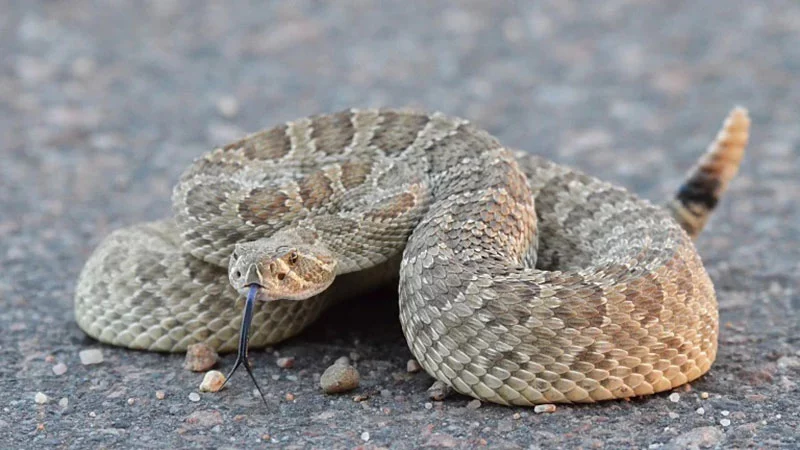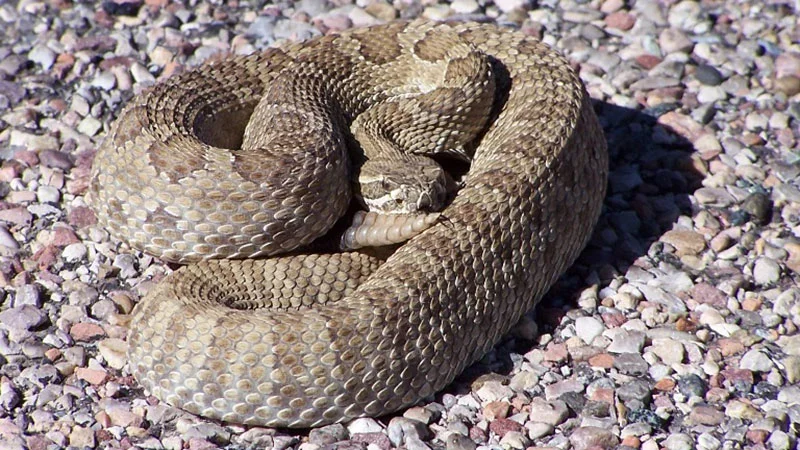
Summer is peak season for rattlesnakes as these creatures that are native to Colorado sun themselves on the same open trails and rocks that attract hikers, walkers and cyclists.
During years when we enjoy a wet spring — like this one — medical experts also see spikes in rattlesnake bites.
That’s because snakes venture out of their hiding places to take advantage of plentiful prey — typically mice and other small creatures — that proliferate during wet seasons more than periods of drought.
“This is definitely the peak time to see them,” said Dr. Brian Jekich, an emergency medicine doctor at UCHealth Yampa Valley Medical Center. “They’re hungry and are looking for something to eat, and they like to sun themselves during these long summer days.”
While bites from rattlesnakes — the only venomous snakes in Colorado — are relatively rare, Jekich warned that rattlesnake bites can have serious consequences.
Rattlesnake venom is a hemotoxin that causes bleeding, bruising and swelling. Rarely, some people might have an allergic reaction that can rapidly lead to a bad outcome. Jekich’s advice: It’s better to be safe than sorry, and head to the nearest ER for evaluation as quickly as possible, even if you aren’t certain whether a bite is from a venomous snake or whether a snake punctured your skin deeply enough to release its poison.
How common are rattlesnake bites?
There are about 5,000 snake bites annually in the United States, and fatalities are rare, with fewer than 10 deaths per year. Still, hospital emergency medicine providers keep antivenom in stock to treat bites when needed.
“It’s the only effective antidote for a rattlesnake bite, which is why it’s important to come in and be evaluated if you are bitten by a rattlesnake. Symptoms can develop quickly, so we want you to come in right away, and if needed, be treated with antivenom,” Jekich said.

What are the symptoms of a rattlesnake bite?
Here are the symptoms of a snake bite, according to Jekich and experts at Colorado State University Extension and California Poison Control:
- Two visible fang marks (if the snake is venomous)
- Possible teeth marks from the bite
- Swelling and pain in the bite area
- Blue and black discoloration of the tissue
- Nausea
- Painful swelling of lymph nodes in the groin and armpit areas within about an hour of the bite
- Possible bleeding or bruising
- Difficulty breathing
- Drooling
- Extreme pain
- Lightheadedness
- Shock (in rare cases)
What’s the first thing you should do if you get a rattlesnake bite?
- Call 911.
- Seek help fast. As experts at Colorado State University say, “The most useful snakebite first aid kit consists of car keys and a phone to call the hospital or a poison center.”
- Try to stay as calm as possible.
- Elevate the site of the bite on the way to the hospital.
- In Colorado, you can call Rocky Mountain Poison and Drug Safety at 303.389.1100.
How much time do I have to get help before a rattlesnake bite could kill me?
It’s best to get help as fast as possible. In the ideal scenario, you’ll want to receive treatment from an emergency medicine doctor within an hour after a snake bite. Without antivenom, the impacts from the snake bite will worsen over time. That’s why you’ll want to get treatment within hours of the bite, if possible.
What if I’m in the backcountry or in a wilderness area and a rattlesnake bites me?
Similar rules apply if you get a snake bite in the backcountry or a remote area. Seek help quickly.
Jekich advises hikers and backpackers to stay as calm as possible and to reduce exertion because an elevated heart rate increases the speed at which the venom spreads in the bloodstream.
Here’s other guidance for dealing with a snake bite if you’re a backpacker or a hiker and you’re in a remote area.
- Make sure you’re in a safe area. Get away from the snake to prevent additional bites.
- Seek help as fast as possible.
- If you have phone service, call 911.
- If you have a satellite device, trigger it to seek help from search and rescue experts.
- Stop any major bleeding.
- Check for clear airways to make sure the person who has been bitten can breathe.
- Clean the wound gently with soap and water.
- Try to immobilize the area of the bite.
- Remove any jewelry or items of clothing that might constrict around the bite area. It’s typical for snake venom to cause swelling.
- If you can’t reach emergency responders and can’t call for help, try to walk out to a car or road and seek help as quickly as possible.
Is it true that rattlesnakes only bite when they’re surprised or are defending themselves?
Yes. Rattlesnakes are shy and generally reclusive. Typically, people get bitten when they “put their hands where they’re not supposed to” and startle the creatures, such as under rocks or in cool, dark places. In a garden, they might lurk under tall plants, flowers, pots or other outdoor equipment such as shovels. They can also slither onto surfaces on warm days to soak up the sun. That’s when hikers can accidentally step on them. And a Colorado 11-year-old suffered a rattlesnake bite a couple of summers ago when he fell on his mountain bike on a trail near Golden and accidentally landed on a rattlesnake.
Jekich warned people never to confront or provoke snakes by poking them or throwing sticks or rocks at them.
“When you’re enjoying the beauty and bounty of Colorado’s natural areas, give snakes a lot of space and leave them alone. They will usually disappear as quickly as they appear, but they can bite when they feel frightened or threatened,” Jekich said.

Do’s and don’ts when it comes to rattlesnake bites.
If a snake bites you, get to a hospital as soon as possible or call 911. Never touch the snake; if possible, take a picture of the snake so you can describe any distinctive features to medical staff.
“Don’t handle the snake after you’ve been bitten. Additional bites can actually occur when people try to retrieve the snake and bring it to the hospital,” Jekich said. “Snakes can still deliver a venomous bite hours, and even days, after they’re dead.”
Symptoms of a venomous bite include pain, swelling, redness and bruising near the bite site.
Here are tips to deal with snake bites:
- Do permit the bite site to bleed for a short period of time, then cleanse and wrap the wound lightly with a bandage.
- Do use a splint if possible if the bite is on the leg or arm.
- Do limit the use of whatever limb was bitten, as much as possible.
- Do remove rings, watches and bracelets if the bite is on the hand or fingers.
- Do not use suction devices commonly sold in outdoor medical kits in an attempt to remove the venom.
- Do not suck the venom from the wound with your mouth as the venom could make you sick. Sucking on the wound can also spread more bacteria to the wound.
- Do not use a tourniquet around the wound.
- Do not cut the wound to express the venom as this can worsen tissue injury from the bite.
How doctors treat rattlesnake bite victims in the hospital
Not all rattlesnake bites contain venom, with about 25% being “dry bites,” and not all venomous bites require antivenom treatment. Factors including patient age, bite location, and whether the venom is causing severe bleeding or swelling near the bite or circulation issues will determine if antivenom is needed.
Lab tests and a period of observation in the emergency department are helpful. Doctors will evaluate the symptoms of a venomous bite. Symptoms may take hours to emerge.
“For travelers coming here, and for Colorado residents who travel to other states, the safest course of action is to have local experts at the nearest ER see you if you are bitten,” Jekich said.
“Your best means of treatment is at a hospital.”

How do I identify a rattlesnake?
Colorado is home to 25 snake species, and only two are venomous, according to Colorado State University experts who provided the following information about how to identify snakes in Colorado:
The two venomous snakes in Colorado are the western rattlesnake (Crotalus viridis) and the massasauga (Sistrurus catenatus).
Rattlesnakes live throughout Colorado while the massasauga only live in southeastern grasslands.
There are six basic ways to distinguish these two venomous snakes from their nonvenomous relatives:
- Rattles at the end of the tail.
- Fangs, in addition to their rows of teeth.
- Facial pits between the nostrils and eyes.
- Vertical and elliptical pupils that may look like thin lines in bright
light. (Nonvenomous snakes have round pupils.) - A single row of scales between the vent and the tip of the tail. (Nonvenomous
snakes have two rows of scales.) - Broad triangular head and narrow neck.
Bull snakes, which are also found in Colorado, look similar to rattlesnakes and deter predators by mimicking rattlesnakes’ coiling behavior. However, bull snakes are usually a lot bigger than rattlesnakes. They often hang out near water, including irrigation fields and canals, and they can be very aggressive. Bull snakes are non-venomous and don’t have fangs. But they do bite.
